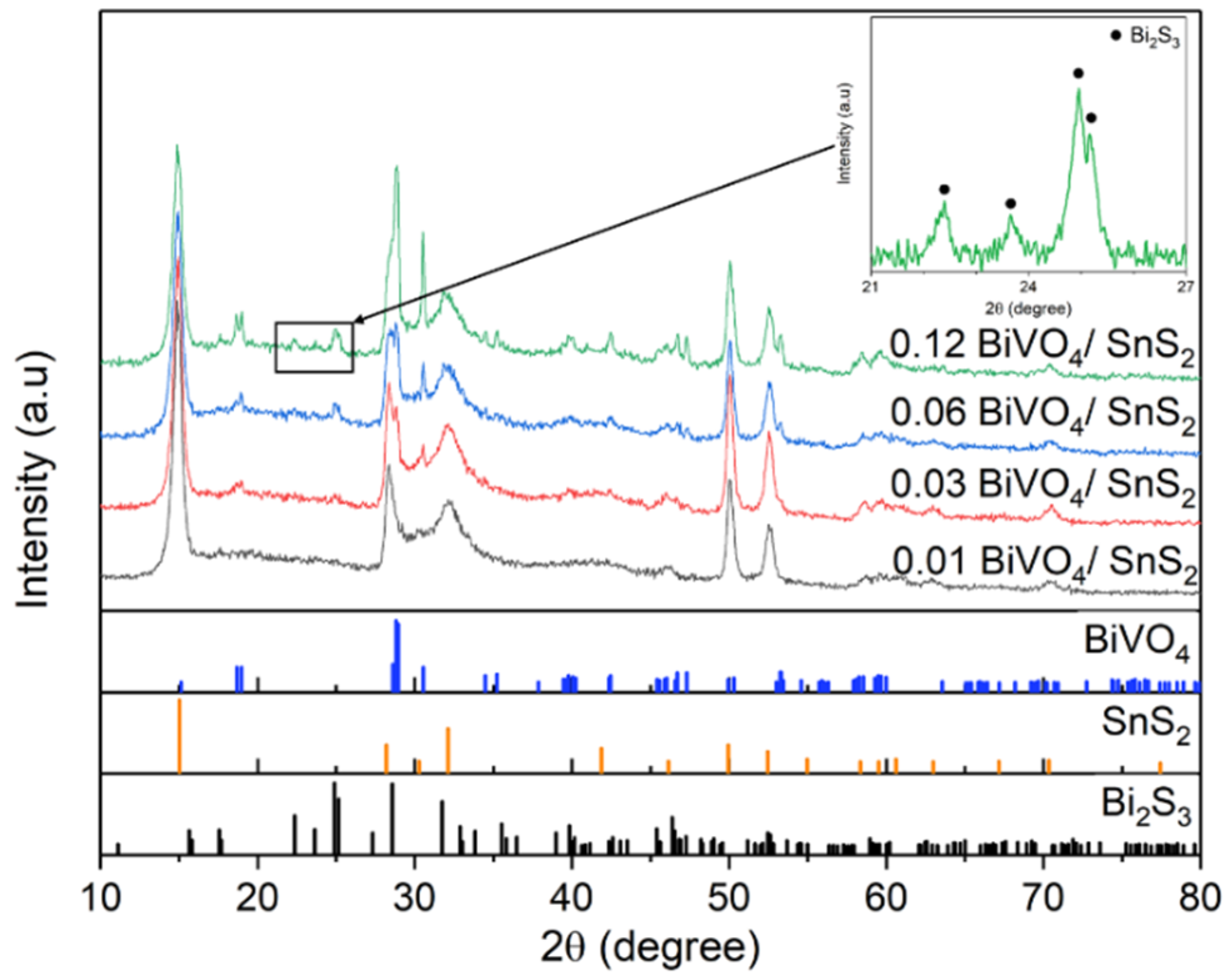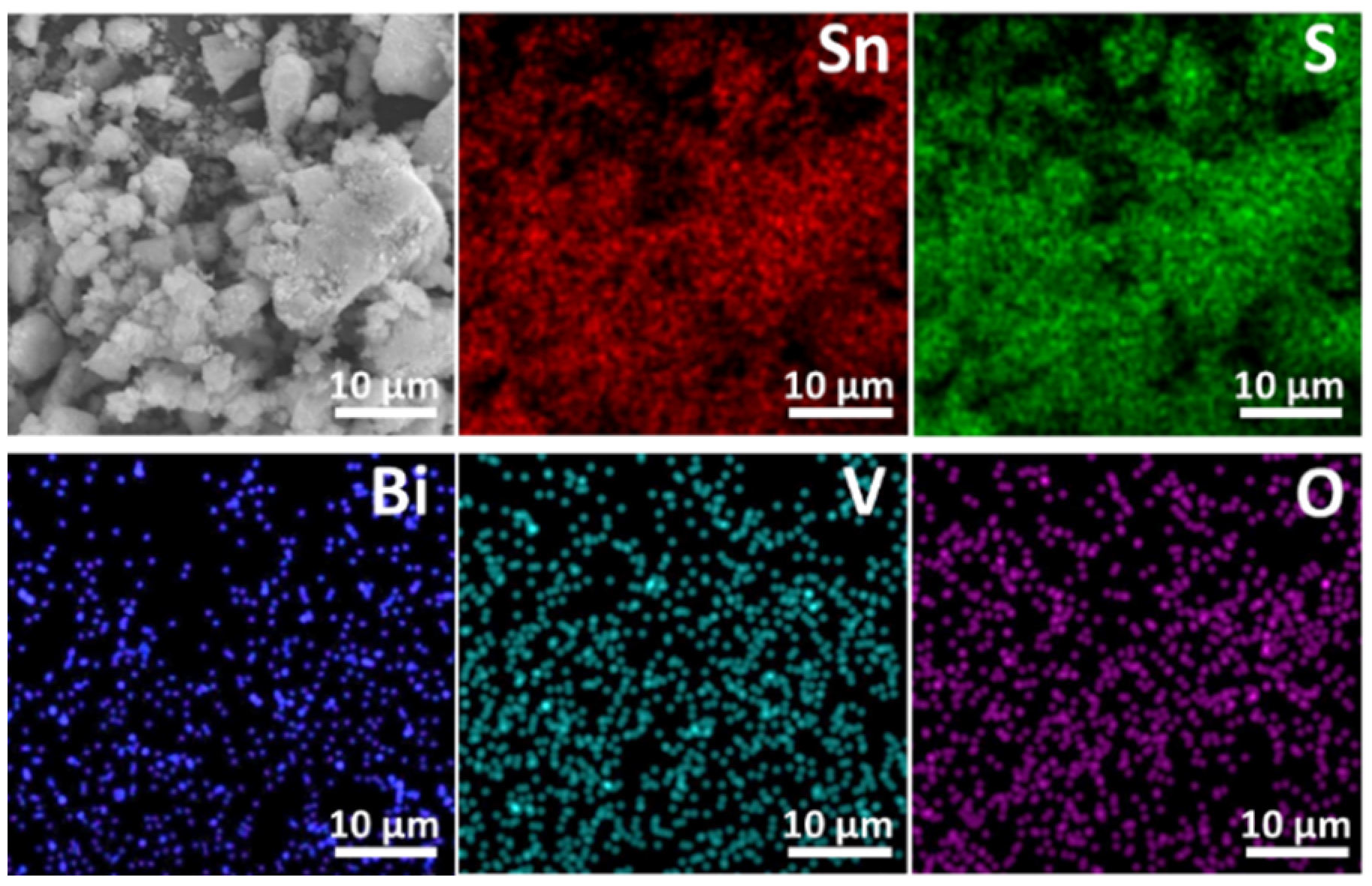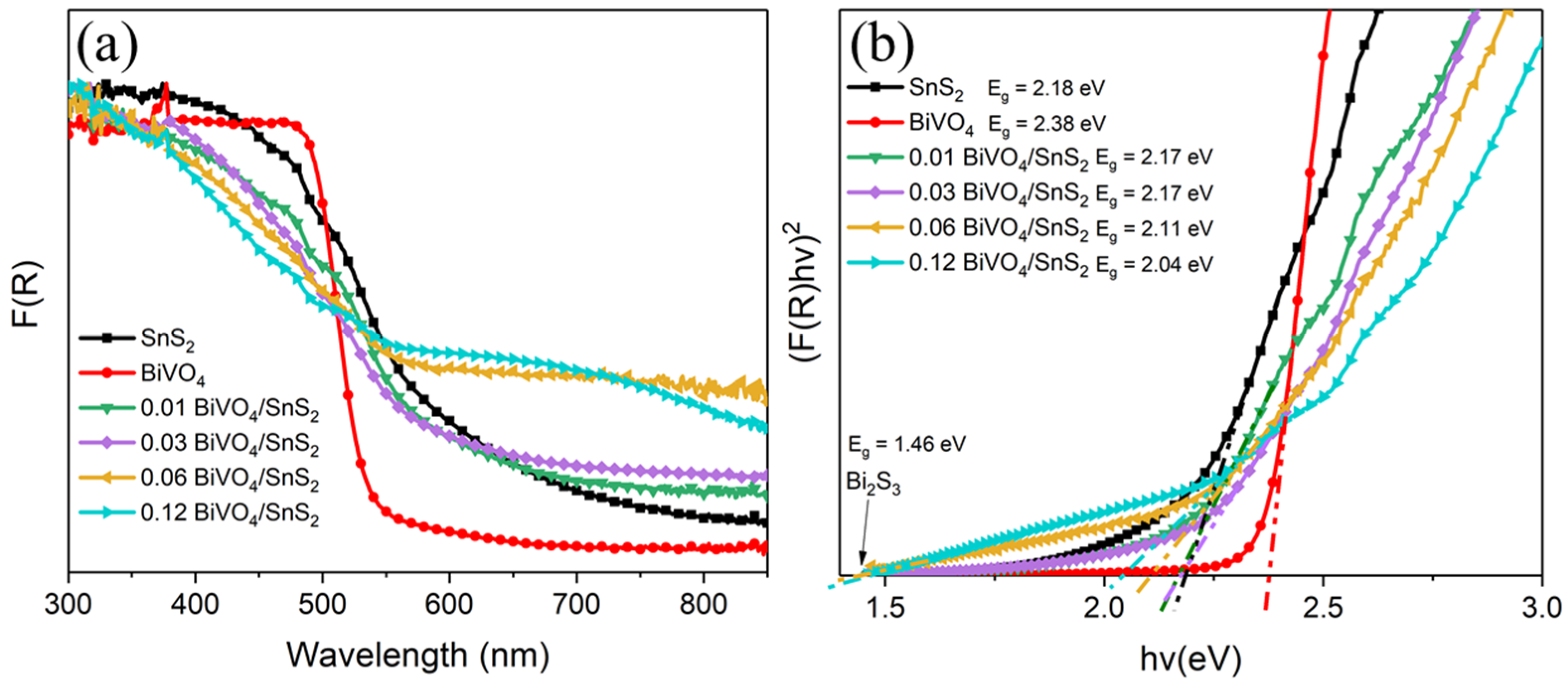Enhanced Photocatalytic Activity of BiVO4/Bi2S3/SnS2 Heterojunction under Visible Light
Abstract
:1. Introduction
2. Results and Discussions
2.1. Crystal Structure of the Samples
2.2. Morphology and Microstructure of the Samples
2.3. Optical Absorption Properties
2.4. X-Ray Photoelectron Spectroscopy (XPS)
2.5. Photocatalytic Activity
2.6. Possible Mechanism for Photocatalytic Activity Enhancement of BiVO4/Bi2S3/SnS2 Heterojunction
3. Materials and Methods
3.1. Materials
3.2. Preparation of SnS2
3.3. Preparation of BiVO4
3.4. Preparation of BiVO4/Bi2S3/SnS2 Composites
3.5. Characterization
3.6. Photocatalytic Activity Measurement
4. Conclusions
Supplementary Materials
Author Contributions
Funding
Acknowledgments
Conflicts of Interest
References
- Kumar, N.; Krishnarao, N.; Singh, S.A. Cocatalyst free Z-schematic enhanced H2 evolution over LaVO4/BiVO4 composite photocatalyst using Ag as an electron mediator. Appl. Catal. B Environ. 2018, 220, 512–523. [Google Scholar] [CrossRef]
- Ke, J.; Liu, J.; Sun, H.; Zhang, H.; Duan, X.; Liang, P.; Li, X.; Tade, M.O.; Liu, S.; Wang, S. Facile assembly of Bi2O3/Bi2S3/MoS2 n-p heterojunction with layered n-Bi2O3 and p -MoS2 for enhanced photocatalytic water oxidation and pollutant degradation. Appl. Catal. B Environ. 2017, 200, 47–55. [Google Scholar] [CrossRef]
- Ai, G.; Mo, R.; Chen, Q.; Xu, H.; Yang, S.; Li, H.; Zhong, J. TiO2/Bi2S3 core-shell nanowire arrays for photoelectrochemical hydrogen generation. RSC Adv. 2015, 5, 13544–13549. [Google Scholar] [CrossRef]
- Shown, I.; Samireddi, S.; Chang, Y.C.; Putikam, R.; Chang, P.H.; Sabbah, A.; Fu, F.Y.; Chen, W.F.; Wu, C.I.; Yu, T.Y.; et al. Carbon-doped SnS2 nanostructure as a high-efficiency solar fuel catalyst under visible light. Nat. Commun. 2018, 9. [Google Scholar] [CrossRef] [PubMed] [Green Version]
- Kim, R.; Kim, J.; Do, J.Y.; Seo, M.W.; Kang, M. Carbon Dioxide Photoreduction on the Bi2S3 / MoS2 Catalyst. Catalysts 2019, 18, 998. [Google Scholar] [CrossRef] [Green Version]
- Yu, C.; Wang, K.; Yang, P.; Yang, S.; Lu, C.; Song, Y.; Dong, S.; Sun, J.; Sun, J. One-pot facile synthesis of Bi2S3/SnS2/Bi2O3 ternary heterojunction as advanced double Z-scheme photocatalytic system for efficient dye removal under sunlight irradiation. Appl. Surf. Sci. 2017, 420, 233–242. [Google Scholar] [CrossRef]
- Kgoetlana, C.M.; Malinga, S.P.; Dlamini, L.N. Photocatalytic Degradation of Chlorpyrifos with Mn-WO3/SnS2 Heterostructure. Catalysts 2020, 10, 699. [Google Scholar] [CrossRef]
- Cao, J.; Xu, B.; Lin, H.; Luo, B.; Chen, S. Novel Bi2S3-sensitized BiOCl with highly visible light photocatalytic activity for the removal of rhodamine B. Catal. Commun. 2012, 26, 204–208. [Google Scholar] [CrossRef]
- Lin, C.; Zhu, M.; Zhang, T.; Liu, Y.; Lv, Y.; Li, X.; Liu, M. Cellulose/SnS2 composite with enhanced visible-light photocatalytic activity prepared by microwave-assisted ionic liquid method. RSC Adv. 2017, 7, 12255–12264. [Google Scholar] [CrossRef] [Green Version]
- Zhang, Z.; Shao, C.; Li, X.; Sun, Y.; Zhang, M.; Mu, J.; Zhang, P.; Guo, Z.; Liu, Y. Hierarchical assembly of ultrathin hexagonal SnS2 nanosheets onto electrospun TiO2 nanofibers: Enhanced photocatalytic activity based on photoinduced interfacial charge transfer. Nanoscale 2013, 5, 606–618. [Google Scholar] [CrossRef] [PubMed] [Green Version]
- Zhang, Y.C.; Du, Z.N.; Li, K.W.; Zhang, M.; Dionysiou, D.D. High-performance visible-light-driven SnS2/SnO2 nanocomposite photocatalyst prepared via in situ hydrothermal oxidation of SnS2 nanoparticles. ACS Appl. Mater. Interfaces 2011, 3, 1528–1537. [Google Scholar] [CrossRef]
- Safaei, J.; Ullah, H.; Aida, N.; Firdaus, M.; Noh, M.; Fairus, M.; Tahir, A.A.; Ahmad, N.; Adib, M. Enhanced photoelectrochemical performance of Z-scheme g-C3 N4/BiVO4 photocatalyst. Appl. Catal. B Environ. 2018, 234, 296–310. [Google Scholar] [CrossRef]
- Li, X.; Li, Y.; Shen, J.; Ye, M. A controlled anion exchange strategy to synthesize Bi2S3 nanoparticles/plate-like Bi2WO6 heterostructures with enhanced visible light photocatalytic activities for Rhodamine B. Ceram. Int. 2016, 42, 3154–3162. [Google Scholar] [CrossRef]
- Xu, Q.; Zhang, L.; Yu, J.; Wageh, S.; Al-Ghamdi, A.A.; Jaroniec, M. Direct Z-scheme photocatalysts: Principles, synthesis, and applications. Mater. Today 2018, 21, 1042–1063. [Google Scholar] [CrossRef]
- Ma, D.K.; Guan, M.L.; Liu, S.S.; Zhang, Y.Q.; Zhang, C.W.; He, Y.X.; Huang, S.M. Controlled synthesis of olive-shaped Bi2S3/BiVO4 microspheres through a limited chemical conversion route and enhanced visible-light-responding photocatalytic activity. Dalt. Trans. 2012, 41, 5581–5586. [Google Scholar] [CrossRef]
- Wang, J.; Jin, J.; Wang, X.; Yang, S.; Zhao, Y.; Wu, Y.; Dong, S.; Sun, J.; Sun, J. Facile fabrication of novel BiVO4/Bi2S3/MoS2 n-p heterojunction with enhanced photocatalytic activities towards pollutant degradation under natural sunlight. J. Colloid Interface Sci. 2017, 505, 805–815. [Google Scholar] [CrossRef]
- Wu, Z.; Chen, L.; Xing, C.; Jiang, D.; Xie, J.; Chen, M. Controlled synthesis of Bi2S3/ZnS microspheres by an in situ ion-exchange process with enhanced visible light photocatalytic activity. J. Chem. Soc. Dalt. Trans. 2013, 42, 12980–12988. [Google Scholar] [CrossRef]
- Vattikuti, S.V.P.; Byon, C. Bi2S3 nanorods embedded with MoS2 nanosheets composite for photodegradation of phenol red under visible light irradiation. Superlattices Microstruct. 2016, 100, 514–525. [Google Scholar] [CrossRef]
- Gao, X.; Huang, G.; Gao, H.; Pan, C.; Wang, H.; Yan, J.; Liu, Y.; Qiu, H.; Ma, N.; Gao, J. Facile fabrication of Bi2S3/SnS2 heterojunction photocatalysts with efficient photocatalytic activity under visible light. J. Alloys Compd. 2016, 674, 98–108. [Google Scholar] [CrossRef] [Green Version]
- Ren, L.Z.; Zhang, D.E.; Hao, X.Y.; Xiao, X.; Gong, J.Y.; Wang, M.Y.; Tong, Z.W. Synthesis and photocatalytic performance of Bi2S3/SnS2 heterojunction. Funct. Mater. Lett. 2017, 10, 3–7. [Google Scholar] [CrossRef]
- Zhuang, C.; Tang, L.; Yu, Z.; Peng, T.; Zhang, Y.; Li, L.; Zhou, Y.; Zou, Z. Hollow BiVO4/Bi2S3 cruciate heterostructures with enhanced visible-light photoactivity. Catal. Sci. Technol. 2019, 9, 182–187. [Google Scholar] [CrossRef]
- Zhang, Y.C.; Du, Z.N.; Li, K.W.; Zhang, M. Size-controlled hydrothermal synthesis of SnS2 nanoparticles with high performance in visible light-driven photocatalytic degradation of aqueous methyl orange. Sep. Purif. Technol. 2011, 81, 101–107. [Google Scholar] [CrossRef]
- Zhang, G.; Du, X.; Wang, Y.; Wang, H.; Wang, W.; Fu, Z. Controllable synthesis of SnS2 nanostructures with high adsorption and photocatalytic activities. Mater. Sci. Semicond. Process. 2017, 64, 77–84. [Google Scholar] [CrossRef]
- Walsh, A.; Yan, Y.; Huda, M.N.; Al-Jassim, M.M.; Wei, S.H. Band edge electronic structure of BiVO4: Elucidating the role of the Bi s and V d orbitals. Chem. Mater. 2009, 21, 547–551. [Google Scholar] [CrossRef]
- Chen, H.Q.; Lin, L.Y.; Chen, S.L. Direct Growth of BiVO4/Bi2S3 Nanorod Array on Conductive Glass as Photocatalyst for Enhancing the Photoelectrochemical Performance. ACS Appl. Energy Mater. 2018, 1, 6089–6100. [Google Scholar] [CrossRef]
- Zheng, Y.; Zheng, L.; Zhan, Y.; Lin, X.; Zheng, Q.; Wei, K. Ag/ZnO heterostructure nanocrystals: Synthesis, characterization, and photocatalysis. Inorg. Chem. 2007, 46, 6980–6986. [Google Scholar] [CrossRef]
- Li, X.H.; Xu, H.Y.; Zhang, X.T.; Liu, Y.C.; Sun, J.W.; Lu, Y.M. Local chemical states and thermal stabilities of nitrogen dopants in ZnO film studied by temperature-dependent x-ray photoelectron spectroscopy. Appl. Phys. Lett. 2009, 95. [Google Scholar] [CrossRef]
- Vattikuti, S.V.P.; Shim, J.; Byon, C. Synthesis, characterization, and optical properties of visible light-driven Bi2S3 nanorod photocatalysts. J. Mater. Sci. Mater. Electron. 2017, 28, 14282–14292. [Google Scholar] [CrossRef]
- Vattikuti, S.V.P.; Shim, J.; Byon, C. 1D Bi2S3 nanorod/2D e-WS2 nanosheet heterojunction photocatalyst for enhanced photocatalytic activity. J. Solid State Chem. 2018, 258, 526–535. [Google Scholar] [CrossRef]
- Zhang, Z.; Xu, R.; Wang, Z.; Dong, M.; Cui, B.; Chen, M. Visible-Light Neural Stimulation on Graphitic-Carbon Nitride/Graphene Photocatalytic Fibers. ACS Appl. Mater. Interfaces 2017, 9, 34736–34743. [Google Scholar] [CrossRef] [PubMed]
- Pearson, R.G. Absolute electronegativity and hardness: Application to inorganic chemistry. Inorg. Chem. 1988, 27, 734–740. [Google Scholar] [CrossRef]
- Yu, L.; Zhang, X.; Li, G.; Cao, Y.; Shao, Y.; Li, D. Highly efficient Bi2O2CO3/BiOCl photocatalyst based on heterojunction with enhanced dye-sensitization under visible light. Appl. Catal. B Environ. 2016, 187, 301–309. [Google Scholar] [CrossRef]
- Cheng, H.; Huang, B.; Dai, Y.; Qin, X.; Zhang, X. One-step synthesis of the nanostructured AgI/BiOI composites with highly enhanced visible-light photocatalytic performances. Langmuir 2010, 26, 6618–6624. [Google Scholar] [CrossRef]








| Sample | Molar Percent of BiVO4 (mole %) | Weight Percent of BiVO4 (wt %) | BET Specific Surface Area (m2/g) | Degradation Rate Constant k (10−3 min−1) | R2 |
|---|---|---|---|---|---|
| SnS2 | 0 | 0 | 75.7 | 0.60 | 0.9408 |
| 0.01 BiVO4/SnS2 | 0.99 | 1.74 | 83.3 | 1.40 | 0.9990 |
| 0.03 BiVO4/SnS2 | 2.91 | 5.05 | 74.7 | 1.60 | 0.9975 |
| 0.06 BiVO4/SnS2 | 5.66 | 9.60 | 68.5 | 1.25 | 0.9965 |
| 0.12 BiVO4/SnS2 | 10.71 | 17.53 | 56.3 | 0.68 | 0.9955 |
| BiVO4 | 100 | 100 | 0.6 | 0.55 | 0.9625 |
Publisher’s Note: MDPI stays neutral with regard to jurisdictional claims in published maps and institutional affiliations. |
© 2020 by the authors. Licensee MDPI, Basel, Switzerland. This article is an open access article distributed under the terms and conditions of the Creative Commons Attribution (CC BY) license (http://creativecommons.org/licenses/by/4.0/).
Share and Cite
Meng, S.; Ogawa, T.; Okumura, H.; Ishihara, K.N. Enhanced Photocatalytic Activity of BiVO4/Bi2S3/SnS2 Heterojunction under Visible Light. Catalysts 2020, 10, 1294. https://doi.org/10.3390/catal10111294
Meng S, Ogawa T, Okumura H, Ishihara KN. Enhanced Photocatalytic Activity of BiVO4/Bi2S3/SnS2 Heterojunction under Visible Light. Catalysts. 2020; 10(11):1294. https://doi.org/10.3390/catal10111294
Chicago/Turabian StyleMeng, Sopheak, Takaya Ogawa, Hideyuki Okumura, and Keiichi N. Ishihara. 2020. "Enhanced Photocatalytic Activity of BiVO4/Bi2S3/SnS2 Heterojunction under Visible Light" Catalysts 10, no. 11: 1294. https://doi.org/10.3390/catal10111294






